 |
|||||
|
|||||
| Preview of Stamps Catalogue: VOLUME 1 |
 |
|||||
|
|||||
| Preview of Stamps Catalogue: VOLUME 1 |
Return To Catalogue - Victoria 1854-1856 - More stamps of Victoria - Victoria miscellaneous - Railway stamps - Fiscal stamps
Note: on my website many of the
pictures can not be seen! They are of course present in the catalogue;
contact me if you want to purchase it.
Before the introduction of its own stamps, the stamps of New South Wales were used in Victoria, they can be recognized by the cancels (the 'Butterfly cancels'). Butterfly cancels were used from 1850 to 1851.
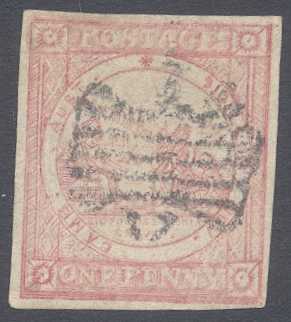
(A so-called butterfly cancel no 1 used in Melbourne)
The numbers correspond to the following towns:
1: Melbourne
2: Kilmore
3: Seymour
4: Broken River
5: Ovens
6: Campaspie
7: Maiden's Punt
8: Dandenong
9: Flooding Creek/Sale
10: Alberton(?)
11: Mount Macedon
12: Mount Alexander
13: Serpentine Creek
14: Swan Hill(?)
15: Geelong
16: Barwon
17: Lake Colac
18: Timboon
19: The Leigh
20: Elephant Bridge
21: Ballan
22: Bunnenyong
23: Burn Bank
24: Horsham
25: Four Posts Inn
26: Chepstowe
27: Fiery Creek
28: Muston's Creek
29: Port Fairy
30: Warnambool
31: The Grange
32: Portland
33: The Glenelg
34: Border Post (later Melbourne?)
35: Upper Glenelg
36: Lake Wallace
37: Melbourne
38: Warnambool
39: William's Town
40: Gisborne
41: Bacchus Marsh
42: Wimmera(?)
43: Kinlochewe(?)
44: Wordy Yallock(?)
45: Bulla Bulla?
46: Crowlands?
47: Ovens
48: Melbourne
49: Melbourne
50: ?
1 p red 2 p lilac to brown (3 types) 3 p blue
The types of the 2 p vary from nicely printed to completely fuzzy.
Value of the stamps |
|||
vc = very common c = common * = not so common ** = uncommon |
*** = very uncommon R = rare RR = very rare RRR = extremely rare |
||
| Value | Unused | Used | Remarks |
| 1 p | RRR | R | Rouletted: RRR |
| 2 p | RRR | RR | Rouletted: RRR |
| 3 p | RRR | R | Perforated 12: RR |


(A so-called 'Butterfly cancel')
The butterfly cancel was the first cancel to be used in Victoria (1849), so called after their shape. A 'V' can be found in the lower part and a number in the upper part. If I'm informed correctly 49 different numbers exist (see above for some of the towns corresponding to the numbers). Click here for more information.

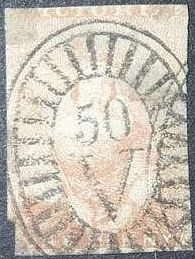
(so-called 'Barred oval' cancel)
The 'Barred oval' cancels were used from 1852 to 1855 (109 different numbers). Number '1' belonged to Melbourne, '2' to Geelong etc Click here for more information.

(Another stamp of Victoria used in New South Wales: with '44'
cancel of Yass)
The above stamps are forgeries, there are two crosses in the lower corners, but there should be letters. The genuine 1 p has the letters E and W in the corners, the 2 p the letters T H or T W. There should be an E in the left corner and an ornament in the other corner for the 3 p value. I've also seen the above 3 p forgery with a lozenge cancel with parallel lines inside it or a pattern of diamonds.
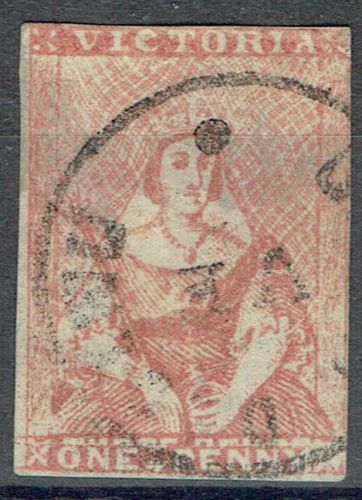

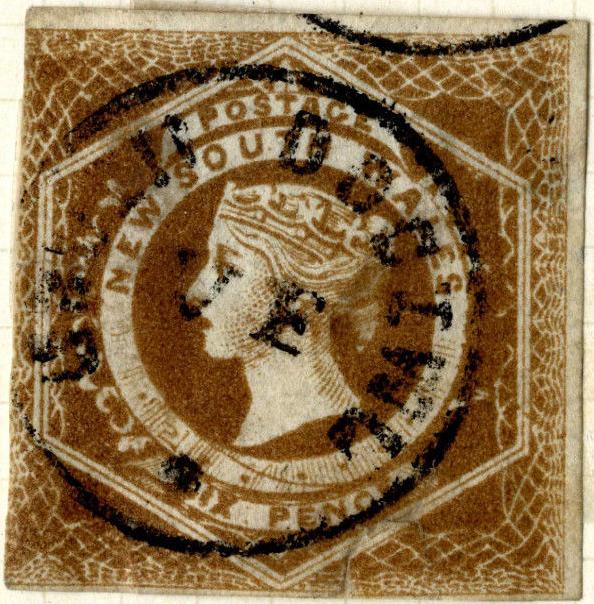
The same forgery with the bottom label "ONE PENNY"
placed too low, such that part of the "THREE PENCE" is
still visible. It has a typical
"VF" cancel with otherwise unreadable letters which
can be found in many other forgeries of other countries, such as
on the forgery of New South Wales to the right of it. Also a
forgery with "ONE PENNY" placed higher up.


Forgery of the 2 p with the label 'TWO PENCE' placed too low in
such a way that the original text 'THREE PENCE'(?) can still be
seen partly. This label also extends too far to the left. Again
there are crosses instead of letters in the bottom corners. Also
this forgery with an unreadable circular
"VF" town cancel.



Forgeries made by Jeffreys. I've seen
a whole sheet of 50 stamps (5 rows of 10 stamps) of these
Jeffreys forgeries. The ornament on the chest of the Queen is too
prominent. I've also seen the 2 p Jeffreys forgery with a '2 V'
cancel resembling the above barred oval genuine cancels. I've
also seen the 3 p forgery with a 'butterfly 1' postmark (see
http://www.stampsofvictoria.com/half.php). The 2 p Jeffreys
forgery only exists with 'TH' corner letters. There is a dark
line from the lip to the chin in both forgeries. Since they were
printed in sheetlets of 10 stamps (2x5), there are 5 varieties of
each forgery (see below).
Jeffreys forgeries, distinguishing
characteristics for each variety:
2 p:
1&6 White line above lower left corner square
2&7 No distinguishing characteristics
3&8 Finger of the right hand is indistinct
4&9 Second "E" of "PENCE" has white blob
5&10 Left hand is not outlined, right forefinger points to
left of "P"
3 p:
1&6 There is a faint line between "RE"
2&7 The lower parts of the cross in the upper right corner
are very thick.
3&8 Top of the "E" in the lower left corner is
broken
4&9 The lower parts of the crosses in the upper corners are
white and blurred
5&10 The second "E" of "THREE" has a top
serif.
Other forgeries:







Oneglia forgeries, note, that the
background is quite different from the genuine stamps. The chin
has a thick outline. The ornament on the chest of the Queen is
also rather distinctive.


Forgeries of the 3 p in green and blue, the "C" of
"VICTORIA" is too squeezed. Also compare the Queen with
a genuine stamp.
Official reprints exist, they were prepared in 1891 and are usually overprinted with the word 'Reprint'. The 2 p always has scratches on it. I have also seen some copies without the 'Reprint' overprint, but cancelled with a very clear '**LBOURNE **2' cancel in a single circle.


A forged 'VICTORIA' cancel taken from a Fournier Album of
Philatelic Forgeries, I don't know on which stamps this forged
cancel was used.
Without country name

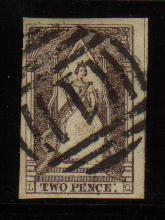
(Reduced sizes)
2 p brown With country name (1856)
1 p green 6 p blue
The 1 p and 6 p have watermark 'Star', the 2 p has no watermark. The 2 p exists lithographed and engraved. Furthermore there are 50 varieties of this stamp (with different corner letters). The stamps were printed in 5 rows of 10 stamps with corner letters 'AE' in the upper left corner, followed by 'BF, 'CG', 'DH' etc upto 'KO'. The second row has letters 'LP' to 'UY', the third row 'VZ' to 'EK', the fourth row 'FL' to 'PU'. Finally the last row has 'QV' to 'WM'. The letter 'J' was not used (see table below). Specialists distinguish an error due to a second printing ('TVO' with YB corner letters; very rare). Some of the later lithographed 2 p stamps look like forgeries due to the wear of the plate and the poor printing (for example the background behind the throne starts to disappear).
Value of the stamps |
|||
vc = very common c = common * = not so common ** = uncommon |
*** = very uncommon R = rare RR = very rare RRR = extremely rare |
||
| Value | Unused | Used | Remarks |
| Imperforate | |||
| 1 p | RR | R | |
| 2 p | RR | R | Blurred and worn impressions exist. |
| Rouletted | |||
| 6 p | RR | *** | |
The letters used in the lower corners of the 2 p engraved stamp (note the 'X' instead of the 'Z' in position 25; and the 'W' instead of 'V' in position 46). The 'WM' in the position 50 represent the name of the engraver(?):
| A E | B F | C G | D H | E I | F K | G L | H M | I N | K O |
| L P | M Q | N R | O S | P T | Q U | R V | S N | T X | U Y |
| V Z | W A | X B | Y C | X D | A F | B G | C H | D I | E K |
| F L | G M | H N | I O | K P | L Q | M R | N S | O T | P U |
| Q V | R W | S X | T Y | U X | W Z | X A | Y B | Z C | W M |
In the lithograpically printed stamps, an error occured making position 30 different ('WA' instead of 'EK').
| A E | B F | C G | D H | E I | F K | G L | H M | I N | K O |
| L P | M Q | N R | O S | P T | Q U | R V | S N | T X | U Y |
| V Z | W A | X B | Y C | X D | A F | B G | C H | D I | W A |
| F L | G M | H N | I O | K P | L Q | M R | N S | O T | P U |
| Q V | R W | S X | T Y | U X | W Z | X A | Y B | Z C | W M |
Reprint:


(Reprints, overprinted 'Reprint')
Forgeries exist: examples:
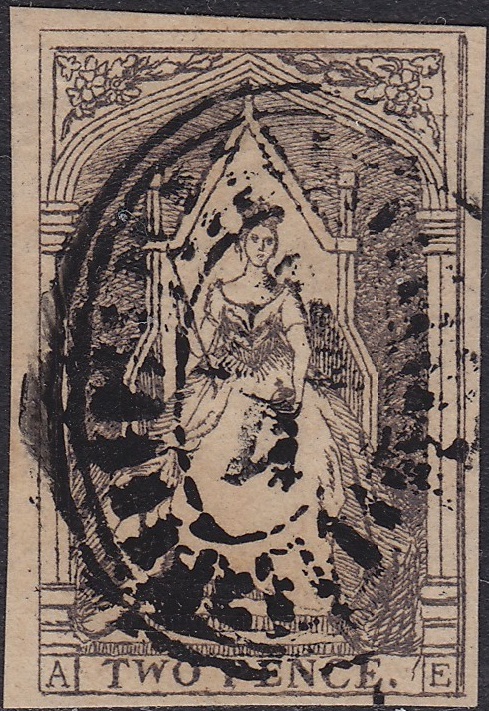


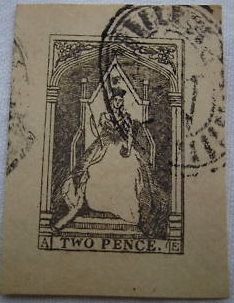
Forgeries, made by Oneglia sometimes
attributed to another Italian forger (Panelli?)
of that period (late 19th century). It can be found in several
shades. The corner letters are always 'AE'. The 'W' of 'TWO' is
placed too high and is too small. In my opinion, the face of the
Queen is too well outlined. I've seen it with a genuinely looking
'barred oval' cancel.

Deceptive engraved forgery with corner letter 'WZ'. The right
hand side frameline is very thick. The bottom of the Queen's
dress is a solid line (instead of a dotted).
Another forgery of the 2 p exists, with corner letters 'QU'. The Queen is not holding a skepter in this forgery (see http://stampsofvictoria.com/queen.php for an example).
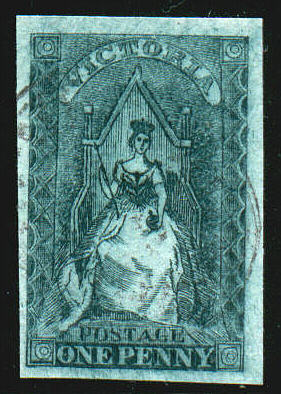

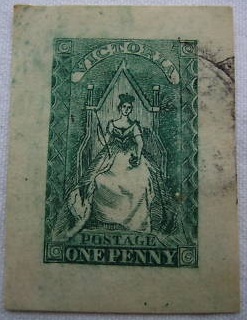

Engraved forgeries, possibly made by Oneglia.
I've also seen this 1 p forgery with a very wide margin, it
exists in bluish green and yellowish green. These forgeries
appear to be a mixture of the styles of the genuine 1 p and the
genuine 2 p.




Forgeries of the 1 p value. A 2 p of this particular forgery also
exists. Although they look quite different to me, I've been told
that they are made by the same forger. Both forgeries have
"S" and "W" in the lower corners and the
bottom of the dress is parallel to the stairs. See also:
http://stampsofvictoria.com/queen.php. I've also seen the above
forgery with part of a circular cancel (instead of the '570'
numeral cancel). No genuine "SW" 2 p stamp exists.



Another "SW" forgery. These corner letters do not
appear in a genuine stamp in this combination. Two slightly
different types, made by the same forger? A similar image appears
in the catalogue of Placido Ramon de Torres
"Album Illustrado para Sellos de Correo" of 1879
(information passed to me thanks to Gerhard Lang, 2016) on page
249.

Mystery stamp, probably a forgery.

6 p brown, forgery in the wrong color!
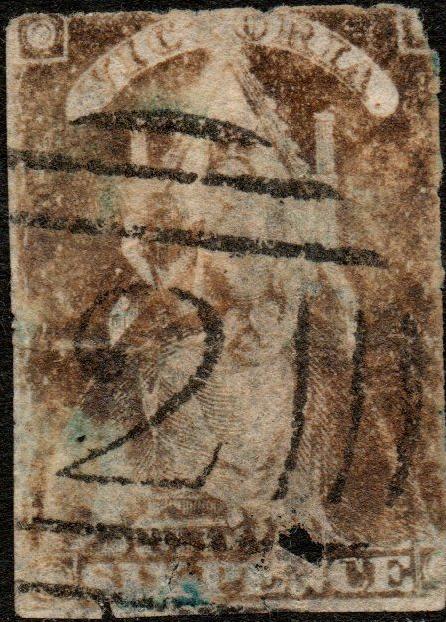
Another 'misprint' of the 6 p in brown color instead of blue.
This looks like a genuine stamp that has received somekind of
chemical treatment to change the color.


6 p forgeries with vertically lined background, the 6 p yellow is
a bogus color.
The forger Jeffreys made a forgery of the 2 p stamp (see http://www.nape.info/media/aug-2007.pdf) with a forged '9' numeral cancel and 'XA' corner letters. The '9' of the cancel is too narrow on top and too wide at the bottom. According to this article, the background shading lines are thicker and there are differences in shape and shading of the Queen’s robes at the lower left of the throne.